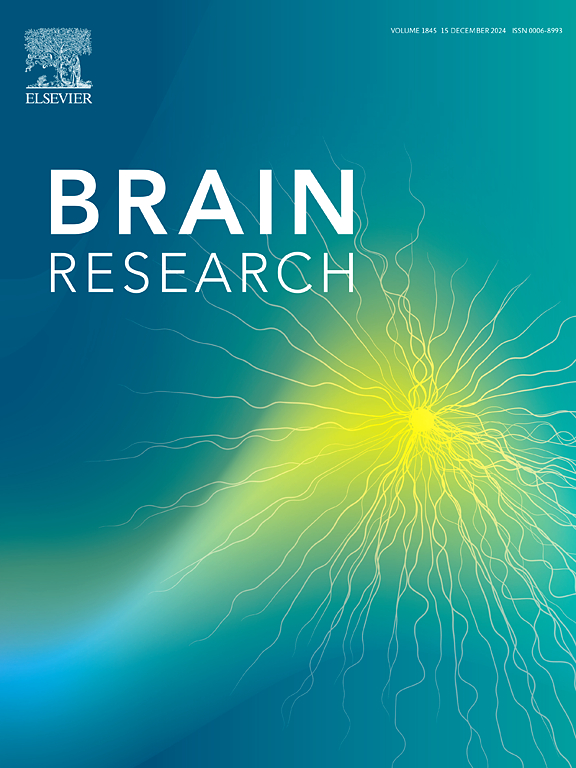羧化锌酞菁对AD模型小鼠脑Aβ的减弱作用。
IF 2.7
4区 医学
Q3 NEUROSCIENCES
引用次数: 0
摘要
聚集性β淀粉样蛋白(a β)的沉积被认为是阿尔茨海默病(AD)的关键因素。先前,我们证明了羧化锌-酞菁(ZnPc)抑制a β原纤维的形成,从而保护培养中的神经元。本研究评价了ZnPc对AD小鼠模型病理改变的影响(J20)。9月龄J20小鼠每周腹腔注射ZnPc(2和4 mg/kg),持续12 周。采用y形迷宫和开阔场地测试评估认知能力。采用近红外显微镜和光谱学方法测定组织中ZnPc的含量。ZnPc主要积聚在肝脏和肾脏。在脑组织中也检测到相当数量,在那里它与神经元、小胶质细胞和细胞外沉积的Aβ共定位。ZnPc(2 mg/kg)显著改善J20小鼠的认知功能。免疫染色结果显示,pbs处理的J20小鼠神经元细胞内、皮层和海马血管周围及实质细胞外a β呈阳性,而znpc处理的J20小鼠细胞内a β呈剂量依赖性明显降低。Nissl染色结果显示,ZnPc处理后大鼠皮质和海马神经元数量均增加,而gfap阳性星形胶质细胞和Iba-1阳性小胶质细胞数量减少。此外,znpc处理组血管数量增加。pbs处理组水通道蛋白4免疫阳性区域超越stl阳性血管延伸至实质,而znpc处理组主要局限于血管周围。znpc处理组Claudin 5水平升高。因此,ZnPc可以减少J20小鼠脑内a β沉积,提示其可能是一种潜在的治疗AD的药物。本文章由计算机程序翻译,如有差异,请以英文原文为准。

Carboxylated Zn-phthalocyanine attenuates brain Aβ in AD model mouse
The deposition of aggregated amyloid β (Aβ) is considered as a key factor for Alzheimer’s Disease (AD). Previously, we demonstrated that a carboxylated Zn-phthalocyanine (ZnPc) inhibits Aβ fibril formation, consequently protects neurons in culture. This study evaluated the effects of ZnPc on pathological changes in an AD mouse model (J20). Nine-month-old J20 mice received weekly intraperitoneal injection of ZnPc (2 and 4 mg/kg) for 12 weeks. Cognitive performance was assessed using Y-maze and open field tests. ZnPc levels in the tissues were evaluated using near-infrared microscopy and spectroscopy. ZnPc accumulated primarily in the liver and kidney. A considerable amount was also detected in brain tissue, where it co-localized with neurons, microglia, and extracellularly deposited Aβ. ZnPc treatment (2 mg/kg) significantly improved cognitive functions of J20 mice. Immunostaining results showed that Aβ was positive intracellularly in neurons, and extracellularly around the vessels and parenchyma in the cortex and hippocampus of PBS-treated J20 mice, which was significantly decreased in ZnPc-treated J20 mice in a dose-dependent manner. Nissl staining demonstrated that neuronal numbers were increased both in the cortex and hippocampus. GFAP-positive astrocytes and Iba-1 positive microglia were decreased by ZnPc treatment. Also, vessel numbers were increased in ZnPc-treated groups. In PBS-treated group, aquaporin 4 immunopositive area extended beyond STL-positive vessels into the parenchyma, which was confined primarily around the vessels in the ZnPc-treated group. Claudin 5 levels were increased in ZnPc-treated group. Therefore, ZnPc can decrease brain Aβ deposition in J20 mice, suggesting it as a potential therapeutic agent for AD.
求助全文
通过发布文献求助,成功后即可免费获取论文全文。
去求助
来源期刊

Brain Research
医学-神经科学
CiteScore
5.90
自引率
3.40%
发文量
268
审稿时长
47 days
期刊介绍:
An international multidisciplinary journal devoted to fundamental research in the brain sciences.
Brain Research publishes papers reporting interdisciplinary investigations of nervous system structure and function that are of general interest to the international community of neuroscientists. As is evident from the journals name, its scope is broad, ranging from cellular and molecular studies through systems neuroscience, cognition and disease. Invited reviews are also published; suggestions for and inquiries about potential reviews are welcomed.
With the appearance of the final issue of the 2011 subscription, Vol. 67/1-2 (24 June 2011), Brain Research Reviews has ceased publication as a distinct journal separate from Brain Research. Review articles accepted for Brain Research are now published in that journal.
 求助内容:
求助内容: 应助结果提醒方式:
应助结果提醒方式:


